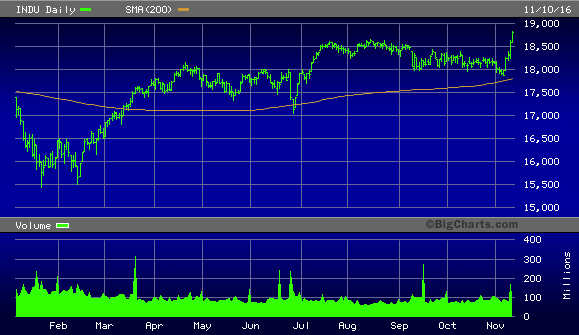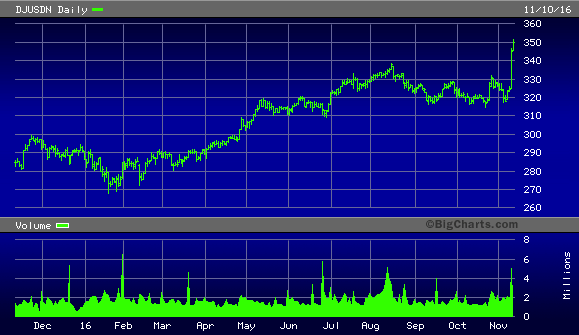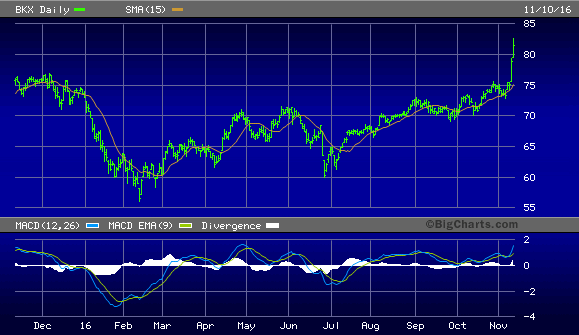They’re calling it the Great Revolution, and rightfully so. Donald Trump’s earth-shattering victory over Hillary Clinton on Nov. 8 must surely rate as one of the greatest political upsets in U.S. history. It stretches the mind to recall the last time a true political outsider won the Oval Office. The prospects of what an independently wealthy and politically unattached President can do for the country are tantalizing to consider.
Let’s leave the hyperbole and political predictions to others, though, and focus on what little can be discerned in the wake of Trump’s historic win. There’s a saying we’re all familiar with: “Don’t listen to what they say, follow the money trail.” That bromide has never been more relevant than it is right now. With that as our starting principle, let’s examine what the “smart money” thinks about Trump’s presidential victory. They’re the ones, after all, who determine the financial market’s course and it’s their opinions that will likely prove most accurate.
In the wake of Mr. Trump’s victory of the U.S. presidency we’re seeing an avalanche of predictions and commentaries from all sides of the political spectrum as to what the President-Elect will do once in office. His opponents vehemently assert he will drag the country into an economic recession – or worse – with his proposed policies. His supporters maintain he will restore American greatness and revitalize the nation’s struggling middle class. Not in ages has there been a more polarized response among both sides of the political divide.
Since no one but Trump himself and perhaps a few insiders can possibly know exactly what his true intentions are, any attempt by outsiders such as me at predicting the coming months would be mere speculation. That doesn’t mean we’re completely without guidance, however. The old tried-and-true bromide that every successful investor knows by heart can always provide valuable insights on what likely will be next, viz. “The tape tells all.”
What exactly does “The tape tells all” mean? It means that while individuals may cast votes on a ballot and share their opinions with pollsters, the only votes that really count are the ones they make with their money. After all, when one’s hard-earned dollars are at stake you tend to think long and hard before placing your “vote” in the marketplace. Campaign promises can be broken and good intentions are ephemeral, but investment decisions typically have bigger consequences. As such, they tend to be made with far greater forethought and longevity than mere spoken words. With that said, let’s examine what the smart boys and girls who vote with their dollars actually think about the prospects of President-Elect Trump’s upcoming reign.
One assumption that many held about a Trump victory was that the global markets would plunge and the economy would deteriorate. Already there were some headlines appearing after the election forecasting a “Trump recession.” The stock market “tape” doesn’t indicate that informed investors are concerned about the prospects of recession under Trump. In fact, the market crash that many had predicted failed to materialize and instead a vigorous rally greeted Wall Street on Wednesday morning after the election. The stock market gained 1.43% on Wednesday despite S&P 500 futures being down 5% at one point overnight. This isn’t the money voting action of a group of insiders concerned about imminent recession or a bear market; it suggests that cooler heads have prevailed against last night’s emotional reaction in the futures market.
One of the best ways of anticipating a president-elect’s policies is to take notice which industry groups are outperforming in the days immediately prior to and following the election. This technique works especially well if the industries in question have been underperforming for an extended period. Again, the rationale behind this is that informed investors are better equipped than outsiders to predict a president’s trade and economic policy intentions. Sudden and dramatic shows of relative strength prior to, and in the wake of, an election are signs that the insiders are buying stocks poised to benefit from those policies.
A couple of weeks ago we discussed the strong performing defense sector and the implication it held for potential military activity in the coming 1-2 years. While my assumption for this was predicated on a Clinton victory, a Trump presidency may still hold the prospects for militarism. Note the stunning performance of the Dow Jones U.S. Defense Index (DJUSDN) on Wednesday in the wake of the election. Defense stocks were one of the top-performing groups for the day as the Defense Index posted a 6.21% gain. The smart money apparently sees the potential for military action even in spite of the President Elect’s dovish rhetoric.
The financial sector has been a star performer since before the election and had another blowout day on Wednesday after the election. Led by the big institutional financial firms like Goldman Sachs (GS), the bank stocks gained an average of 5% for the day while the broker/dealers were up 6% on average. Here’s what the PHLX Bank Index (BKX) looks like as of Wednesday. The index made a new 52-week high as you can see, quite impressive given that the average NYSE stock is still below a 2-year trading range ceiling.
This is an important consideration since leadership and relative strength in the broker/dealer and banks normally carries bullish implications for the broad market. It also tells us that, far from being disturbed by the threatening aspects of a Trump presidency, Wall Street (or at least a large faction of the Street) is apparently enthusiastic about the prospects for success under his administration. Time doesn’t permit a more extensive analysis of the many industry groups and their reactions to Trump’s victory, but we’ll take a closer look at them in the next commentary.
Mastering Moving Averages
The moving average is one of the most versatile of all trading tools and should be a part of every investor’s arsenal. Far more than a simple trend line, it’s a dynamic momentum indicator as well as a means of identifying support and resistance across variable time frames. It can also be used in place of an overbought/oversold oscillator when used in relationship to the price of the stock or ETF you’re trading in.
In my latest book, Mastering Moving Averages, I remove the mystique behind stock and ETF trading and reveal a completely simple and reliable system that allows retail traders to profit from both up and down moves in the market. The trading techniques discussed in the book have been carefully calibrated to match today’s fast-moving and sometimes volatile market environment. If you’re interested in moving average trading techniques, you’ll want to read this book.
Order today and receive an autographed copy along with a copy of the book, The Best Strategies For Momentum Traders. Your order also includes a FREE 1-month trial subscription to the Momentum Strategies Report newsletter:
https://www.clifdroke.com/books/masteringma.html
Clif Droke is a recognized authority on moving averages and internal momentum. He is the editor of the Momentum Strategies Report newsletter, published since 1997. He has also authored numerous books covering the fields of economics and financial market analysis. His latest book is Mastering Moving Averages. For more information visit www.clifdroke.com









